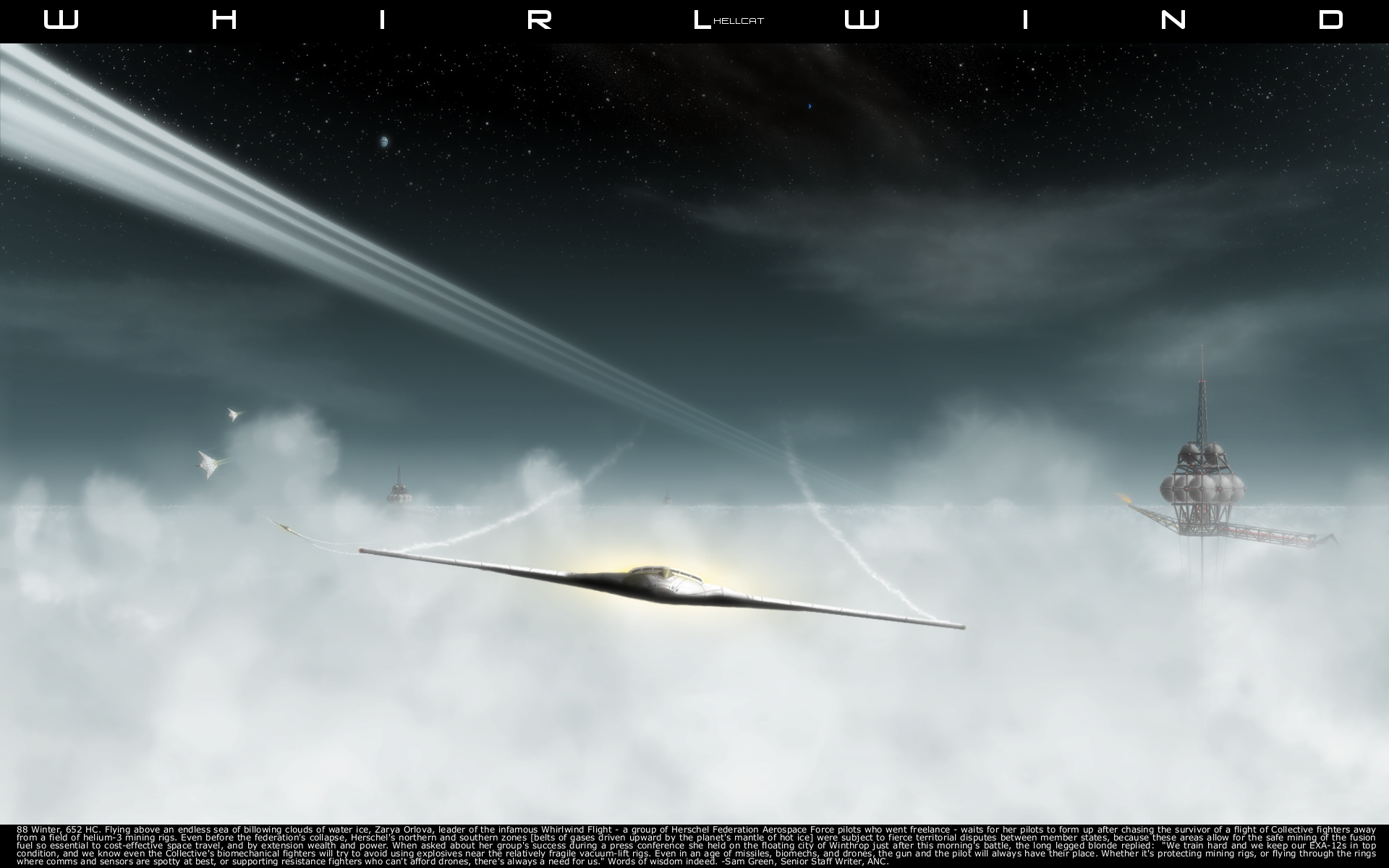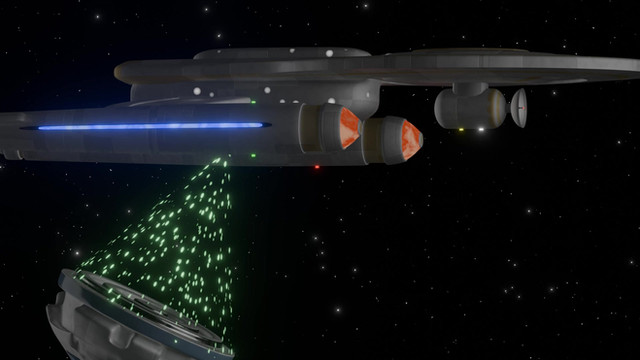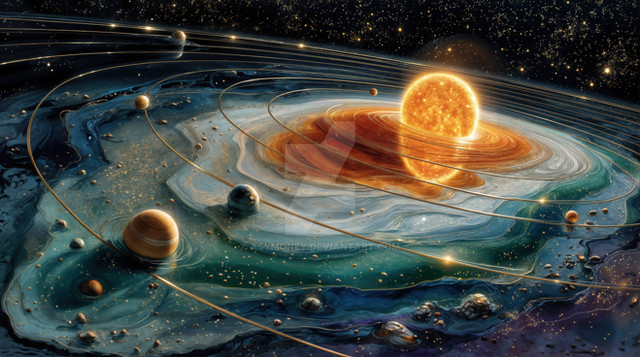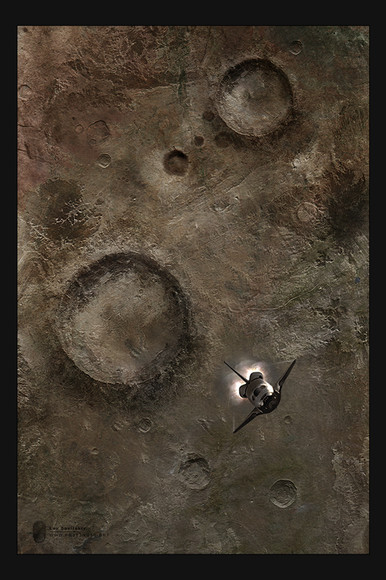HOME | DD
 HellcatF6F — Whirlwind
HellcatF6F — Whirlwind

Published: 2011-05-06 04:16:04 +0000 UTC; Views: 1833; Favourites: 33; Downloads: 55
Redirect to original
Description
This is my latest GIMP painting, and the first time I have tried my hand at painting artificial objects (I previously only painted landscapes and planets). The backstory was made up specifically for the image's caption, but I may expand upon it.Further information: Herschel is an ice giant, similar to Neptune and Uranus. The interior is made largely of ices of water, ammonia and methane (these ices are actually very hot, but kept in solid form by the tremendous pressures). Trace amounts of methane produce the green hue seen in the background due to absorption of red light.
Helium 3 is valuable as a fusion fuel because, when combined with deuterium, it releases energy in the form of an ionized gas, which can be directed out the back of a spacecraft to propel it. It is mined from the ocean of liquid hydrogen and helium, just above the mantle of ices but hundreds of kilometers below the clouds (the flare on the rig is there for artistic license; to reinforce the parallel to oil rigs).
Related content
Comments: 34

Very nice! good job on the man made structures, and I love the angle of the space ship, very dynamic!
👍: 0 ⏩: 1

Looks like "Ord Ibanna" the air planet from star wars, pure owneage! 
👍: 0 ⏩: 1

Thanks
That did cross my mind as I worked on it. The biggest source of inspiration was Robert L. Forward's Saturn Rukh.
👍: 0 ⏩: 0

Excusem Moi, I believe somewhere I put Jupiter's gravity is 5 G's, but it's not, it's only 2.5
👍: 0 ⏩: 1

Not a problem. Thanks though.
Part of my next project is Herschel as viewed from space. I decided to shelve an underwater scene for now and if all goes well, a ship will be flying through the closer of two gaps in the rings. Two small moons will act as 'Shepherding' satellites, forming the two main gaps, though only one will appear in the picture ([link] ). I have since removed the atmosphere from the moon, realizing that it takes a pretty big body to hold an atmosphere. I replaced it with cryo-volcanic activity, and as soon as I done with the next closest ring I will upload another WIP.
👍: 0 ⏩: 0

Flying wing design. I got a lotta info on spacecraft design if yer interested 
Making something to swoop in a gas giant's clouds and come out again is a huge challenge. It can't land, needs a long flight time, and also a very high thrust AND delta-vee because of the planet's high gravity and even larger mass. Earth is hard enough for these requirements...
👍: 0 ⏩: 2

A nuclear saltwater rocket would produces the necessary combination of thrust and delta vee, but that would kind of defeat the purpose of floating cities and He3 mining platforms. The only other thing I could think of would be inertial confinement fusion.
👍: 0 ⏩: 1

I doubt ICF would work very well in-atmosphere 
I've never been a big fan of it, other than it's very close to possible with current tech, since it requires the sort of reliability of a Vickers' Machine gun [link] (And even those you had to change out the berral), except with a fusion engine with many huge shock absorbers, and a whole array of lasers that must never miss.
He3 mining still makes sense for electrical powerplants (for cities and spaceships) and interstellar fusion engines, which would have a much larger Specific Impulse than any salt water nuclear rocket.
Have you seen atomic rocket/project Rho? [link]
It's a wonderfully amazing resource for this kind of stuff. Especially the engine table: [link]
👍: 0 ⏩: 1

I was looking at that site earlier. It is quite simply an amazing source. Thanks
👍: 0 ⏩: 0

Sure I am interested
I envisioned Herschel to be about the same mass as Neptune so it would not be as bad as Jupiter or even Saturn as far as 'surface' (cloud top) gravity goes.
👍: 0 ⏩: 1

Neptune has a cloudtop G of ~0.89, Neptune is a little more than 1.
I just found that the orbital velocity at Uranus cloudtop is ~15,000 m/s.
Vo = Sqrt(GM/r)
500 km up is 14,906 m/s.
That's very tough compared to Earth's 7,800 m/s, but at least the gravity is roughly the same, so good thrust is needed but nothing crazy like on Jupiter.
I had a huge discussion here [link] about injecting reaction mass into the exhaust stream of a fusion engine to add thrust, but it detracts from the Delta-Vee. A fusion engine would have so much Delta-vee, though, that you could afford the losses.
It works on the idea that you get thrust from m1v1=m2v2, conservation of momentum. Thrust, a force, is linear to increase in velocity.
However, the velocity your propellant travels at from an energy source (fusion in this case) is kinetic energy:
KE = 0.5mv^2
which, solving for velocity, is:
v = Sqrt(KE/0.5m)
So if you quadruple the energy, you only double the velocity, which doubles the thrust. But if you quadruple the mass, you lower the velocity by Sqrt(1/4), (1/2 the velocity), so the net effect is to double your thrust. Add dead weight to the exhaust stream, adds thrust, loses delta-vee. Fusion has way more delta-vee than needed, so that's not a problem. And the best part is, you don't end up with ludicrous a thrust power that will melt/vaporize your spaceship with waste heat, nor does it require an engine with unrealistic T/W ratio. (MCF almost always T/W <1 )
Don't you dare publish that anywhere, it's my idea!
(Or if you do, give plain and visible credit! 
👍: 0 ⏩: 1

That is a very good idea! Do not worry, if I use anybody's ideas, I will always ask first, and give credit.
I have an idea of my own; a radiation deflector. No, nothing even close to the force fields of most hollywood sci-fi, but a physical structure. Rather than use a 'storm cellar' of very thick shielding, the idea is to protect the whole habitat module by reflecting x-rays at grazing angles by using thin nickel foils (similar to an x-ray telescope), sandwiched between hydrogen-rich nanofoam layers to capture neutrons and debris. A ship would have to present the deflector's maximum slope toward the source, but radiators and/or solar cells could be placed on the deflector's upper surface.
👍: 0 ⏩: 1

That's neat! So it's already been used on X-ray telescopes? Seems like it's already been verified to work, then. I'm impressed by the knowledge of material properties, I'm a bit loose in that field.
The key would be: would it reduce mass, as compared to a storm cellar? I think if you multipurpose it with the radiators or solar cells then it would save mass. You should try discussing it on Physics Forums
You've got no need to steal my idea since you've got that one!
I'm putting mine into a technical literature deviation so DA can verify I came up with the idea first for copyright reasons
Maybe on some other sites, too.
👍: 0 ⏩: 2

Also, I was browsing through the Atomic Rockets site and your Orbiter thread and realized that there is a solution to the problem of maintaining a vacuum inside the fusion reactor while still transferring energy to propellant. A quartz 'lightbulb' similar to the ones that would be used in some solid-core NTRs. Instead of being a bulb, it would be a tube.
The fusion plasma would be formed inside the tube, confined by magnets outside of it in a gas dynamic mirror configuration. The infrared, visible, UV and x-rays would pass through the quartz and heat up the propellant flowing around it. By using a low pressure gas inside the quartz tube, the fusion chamber would also act as a gas dynamic laser, producing a beam of photons to keep the atmosphere out of the chamber by thermal expansion. By setting the laser's focal point to just outside the ship, there would be no beam of death that sweeps across the land as the rocket turns in the direction of the planet's rotation. By making the focal point configurable somehow, it would also serve as an aft defense system.
👍: 0 ⏩: 1

A big quartz tube sounds a bit exotic for me, personally my approach would be to use the magnets to compress the fusion products on their way out of the engine (on the "leaky" side) until, at a single point, the pressure exceeds 1 atmosphere, then after that a large expansion section where the water would be injected.
(Hmm. Didn't I mention I was planning on using GDM Fusion? Guess not. But I'm greatly in favor of that idea, since working models have already been built!)
(I've decided to use water again. Thermal expansion would work both ways, and if the expansion section isn't significant enough, it would cause the propellant to flow back into the fusion chamber. The equations described earlier, kinetic energy and momentum, only describe the kinetic impact, and don't take into account thermal expansion. Thermal expansion would be an additional, unnecessary bonus. Water would have the least thermal expansion, and thus the least chance of expanding back into the fusion chamber)
With the methane injection, it would have significantly less exhaust velocity than a pure fusion engine, especially during the atmospheric ascent portion, where the injection would be highest for the most thrust. During the upper-atmosphere ascent, the angle of incidence on the atmosphere, and the fact that you'll be above the vast majority of the atmosphere, tells me that atmospheric drag will be more than enough to stop the exhaust. After all, the SSME's have exhaust at 4,500 m/s, and just a few seconds into the flight they're at a safe altitude. Gas is very light, and so it's very effectively stopped by the atmosphere, I think the "Death-ray" effect of fusion engines is greatly overestimated...
Once again on the quartz tube design, remember thermal expansion works both ways, it could very well flow right back into the chamber. The reason a jet engine works is because of the compression and expansion sections, where the pressure in front of the combustion is greater than in it, so it flows backwards, at least I assume that's why...
👍: 0 ⏩: 1

I know that nuclear fusion is not a doomsday technology (referring to the 'death ray' comment). If I fell for the propaganda, I would not even be having this discussion. I am sorry if I did not type that as clearly as it should have been.
Using a laser to create a vacuum was the product of reading about the Pulsed energy projectile, which would create an explosion at its point of focus. Since a zone of low pressure would be produced briefly, I simply thought of using that to create a temporary vacuum. It probably would not work, but I never said I was an expert.
👍: 0 ⏩: 1

Oh, no. I know you don't think it's a doomsday technology, what I meant is I've seen a few people very concerned at using such a high exhaust velocity in-atmosphere, and I was just saying the high exhaust velocity won't be very dangerous.
None of us here are experts 
It's just I know GDM's have been built, that NASA has researched GDM Fusion Propulsion for interplanetary spacecraft, and that spraying water into the exhaust stream is very much technologically possible. Stick those things together, with the KE=1/2mv^2 and p=mv equations, and you get a very neat idea.
👍: 0 ⏩: 1

I certainly agree. The Saturn 5's first stage produced 115 gigawatts at liftoff and a 200 gigawatt fusion engine will be no worse as far as blast and sound go. The x-rays from the plasma will be quickly absorbed by the atmosphere and re-radiated at longer wavelengths. Neutrons will be mostly absorbed by a lithium blanket to breed tritium (unless aneutronic fusion is used then there will be no neutrons at all), so that is another non-issue.
👍: 0 ⏩: 0

I just now thought of having the fusion engines act as a jet engine. Atmosphere is pulled in, compressed and heated by the reaction. For the most part, people are going to colonize planets that have atmospheres, and air is a fairly heavy mixture of gases. The intake has a spike structure similar to the SR-71, and as speed is gained, the spike closes in until it is pressed all the way forward for a rocket mode. This would allow the creation of SSTOs that resemble the SR-71, because it was simply an awesome aircraft.
For a gas giant, the hydrogen would have to do, but fly fast enough and even that stuff will compress to the degree needed for sufficient thrust.
👍: 0 ⏩: 1

There's no real need for all the added complexity of a jet engine for an Earth-like world, but a gas giant where you want to fly for hours to gather He3, that's a different story! Very awesome idea! If I don't get a name, I'll just credit "HellcatF6F from Deviant Art" In my novel 
(Originally I was going to use a nuclear ramjet for atmospheric flight)
If I may use the idea...
👍: 0 ⏩: 1

Thanks
Ever since I read Saturn Rukh by Robert L. Forward, I thought some kind of human presence in the upper atmosphere of a gas giant would be awesome.
👍: 0 ⏩: 2

A cloud city would be possible with a large enough vacuum lift cell, but a structure that big will test even carbon nanotubes. A better way to do it would be to separate the city into smaller cells, then sink them deep enough where atmospheric pressure inside the cell provides the bouyancy, so that 1: there is sufficient pressure to reduce the strain on the cells and 2: allow people to live inside of the cells rather than on gondolas below them.
I envision groups of vacuum lift airships able to maneuver independently so that wide distance intervals can be maintained during a storm to avoid collision, or a war so that a single nuclear warhead would not destroy every single structure. Each of these airships would be its own township, and small ones would be owned by families, creating something of a nomadic trader culture.
The top of each ship would have landing pads and/or strips and travel between them would be by either fix wing aircraft, helicopers or VTOLs. Launching surface to orbit shuttles could be done with an electromagnetic catapult from the larger ships.
👍: 0 ⏩: 0

I won't really be able to give credit without a name, assuming it's alright if I use the idea...
Sorta makes me think of Bespin's cloud cities
What I'm thinking of is craft entering from orbit, filling up, returning to orbit and transferring the fuel to an orbital vehicle. It's not the best setup, but in the circumstances of what I'm writing they can't set up a cloud station.
In any other circumstance, though, the best thing would be have some vehicles made to gather with atmospheric engines, and others to shuttle it back and forth from orbit. Which means cloud cities would make sense at the spaceports/airports
Never read Saturn Rukh, I have heard of it before, it was a very negative review about the characters and a few words on realism
But I'll take your word if you say it's good.
👍: 0 ⏩: 1

By the way, yes it is alright
Ideas are going to spread no matter what, but it is a good thing because it will provide new material to spawn even newer ideas.
👍: 0 ⏩: 0

This is really good! Love the planetary rings and the depth of the piece!
👍: 0 ⏩: 0

One day, if worthy, i'll sail the skies familiar to that..
👍: 0 ⏩: 1

I painted the clouds one line at a time with the air brush, getting larger and more scattered the closer to the 'camera.' I went over them again with the dodge and burn to give them light and shadow, then smudged, then copied the layer twice and set one to multiply and one to hard light.
The fighter jet was drawn partly with the straight line (Ctrl + right click) tool and free hand (curved parts and panel lines), and carefully colored and shaded. The mining rig was done the same way.
The planet's ring was done by creating a Plasma (located under Filters > Render), desaturating it (Colors > Desaturate), then rotation blurring it and cutting out sections. That was copied twice; one for Gaussian Blur and one for Addition.
The stars were done by using Hurl (Noise > Hurl), at low resolutions for larger stars (scaled up) and at high resolution for background stars. For the best results on stars, set contrast to 80 or more.
👍: 0 ⏩: 0

Thanks
Yes, all of it in GIMP, with the default brush set.
👍: 0 ⏩: 0































